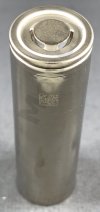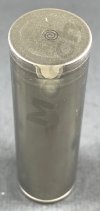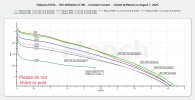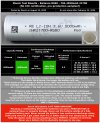These tests below only note my personal opinion for the ESTIMATED ratings for the batteries I tested at the time I tested them. Any battery that is not a genuine Samsung, Sony, Murata, LG, Panasonic, Molicel, EVE, Ampace, Reliance, Sinowatt, Lishen, BAK, or Sanyo can change at any time! This can be one of the hazards of using “rewrapped” or batteries from other manufacturers so carefully research any battery you are considering using before purchasing.
Misusing or mishandling lithium-ion batteries can pose a SERIOUS RISK of property damage, personal injury, or even death. Never use them outside of a fully protected battery pack and you use them at your own risk. Never exceed the battery’s true continuous discharge rating (CDR), never let it get colder than 0°C or hotter than 60°C to help lower the risks and extend cell life, and keep the plastic wrap and top insulating ring in perfect condition. Never use a battery that is physically damaged in any way.
Testing batteries at their limits is dangerous and should never be attempted by anyone who has not thoroughly studied the dangers involved, understands the risks, has the proper equipment, and takes all appropriate safety precautions.
If the battery has only one current rating number, or if it only says "max", then I have to assume the battery is rated at that current level for any type of discharge, including continuous.




Test Results
This is the best performing power cell (above about 15A) we can buy now, beating the EVE 50PL by a little all the way up to about 40A-50A. Above that the 50PL slowly starts becoming the better choice. It’s also a pretty good energy cell (under 10A-15A) too.
A few thoughts…
Continuous Current Discharge Graphs

Ratings and Performance Specs Graphic

18650 Ratings & Performance Table:
21700 Ratings & Performance Table:
I want to work for the community full time! If you feel what I do is worth a couple dollars a month and you would like early access to battery availability, battery testing and news, and a say in what I test, then please consider becoming a patron and supporting my testing efforts: Get more from Battery Mooch on Patreon.
Misusing or mishandling lithium-ion batteries can pose a SERIOUS RISK of property damage, personal injury, or even death. Never use them outside of a fully protected battery pack and you use them at your own risk. Never exceed the battery’s true continuous discharge rating (CDR), never let it get colder than 0°C or hotter than 60°C to help lower the risks and extend cell life, and keep the plastic wrap and top insulating ring in perfect condition. Never use a battery that is physically damaged in any way.
Testing batteries at their limits is dangerous and should never be attempted by anyone who has not thoroughly studied the dangers involved, understands the risks, has the proper equipment, and takes all appropriate safety precautions.
If the battery has only one current rating number, or if it only says "max", then I have to assume the battery is rated at that current level for any type of discharge, including continuous.




Test Results
This is the best performing power cell (above about 15A) we can buy now, beating the EVE 50PL by a little all the way up to about 40A-50A. Above that the 50PL slowly starts becoming the better choice. It’s also a pretty good energy cell (under 10A-15A) too.
A few thoughts…
- At up to about 10A only the EVE 58E, LG M58T, Samsung 58E, and the Vapcell F58/60/63’s ran for a bit longer.
- Only the EVE 50PL beats this cell at high to extreme power levels, above about 50A.
- At high current/power levels the Reliance RS40, due to its incredibly low internal resistance (DC IR), started at a slightly higher voltage/power level but the RS50 soon “catches up” and runs at a higher voltage and for longer.
- The RS50’s DC IR was very low, 5.0-5.3mOhms for the four cells I tested. Only the RS40 was (a little) lower and the other top performers are in the 5.5-6.6mOhm range. Those values are all close though and only apply to the initial instantaneous voltage drop at the start of the discharge. Check the discharge graphs for how the cells you are interested in perform after that.
- The datasheet only has a 70A temp-limited continuous current rating. Reliance says you can run it at up to 70A but you must never let it go over 80°C. This includes after a discharge stops! Like all cells, at very high current levels it can easily rise another 10°C or more after stopping.
- At its 70A datasheet current rating the RS50 was able to deliver about 2.3Ah and it stayed above 3.2V before hitting its temp limit.
- The Reliance web site has a “max pulse discharge current” rating of 250A for this cell but that will certainly speed up its aging no matter how short the pulse is. The datasheet does not have this rating and if you use this cell at above 70A you do so at your own risk!
- I estimate its true continuous current rating to be about 40A as that would bring the cell up to about 80°C. It runs a few degrees hotter than the RS40 at high power levels but I don’t know if this has any effect on cycle life.
- The datasheet charge ratings are confusing and I’m interpreting some terms: 2.5A standard, 8A rated, 15A max continuous. To help extend cell life I recommend staying near or below 2.5A.
- In my opinion 8A will probably shorten cycle life some and 15A will definitely shorten life if done regularly. Occasional fast charging won’t impact the cell much.
- If fast charging a lot then I recommend active cooling to keep the cell below 45°C.
- Two of the four cells I tested delivered 5169mAh and 5173mAh, incredible consistency and well above the 4950mAh minimum capacity rating…which it should be. I like to see cells deliver at least 100mAh more than the rating so we can be sure that none of the others in the batch will be below the rating.
- This extra capacity means nothing above a couple amps so do not get all caught up in comparing capacity ratings, they’re pretty useless.
- Avoid welding within a central 6mm diameter circle (where the spiral is) on the bottom of the cell. You can weld to any part of the top central contact though.
- Since there is no CCC*** logo I am assuming these are pre-production samples of unknown grade. I’ll test the full production cells when available.
- 40A and 100A “shootouts” against the other top performers were done for my Patreon supporters and 40A cell-to-cell consistency testing for them is coming soon.
Continuous Current Discharge Graphs

Ratings and Performance Specs Graphic

18650 Ratings & Performance Table:
21700 Ratings & Performance Table:
I want to work for the community full time! If you feel what I do is worth a couple dollars a month and you would like early access to battery availability, battery testing and news, and a say in what I test, then please consider becoming a patron and supporting my testing efforts: Get more from Battery Mooch on Patreon.
Last edited:
